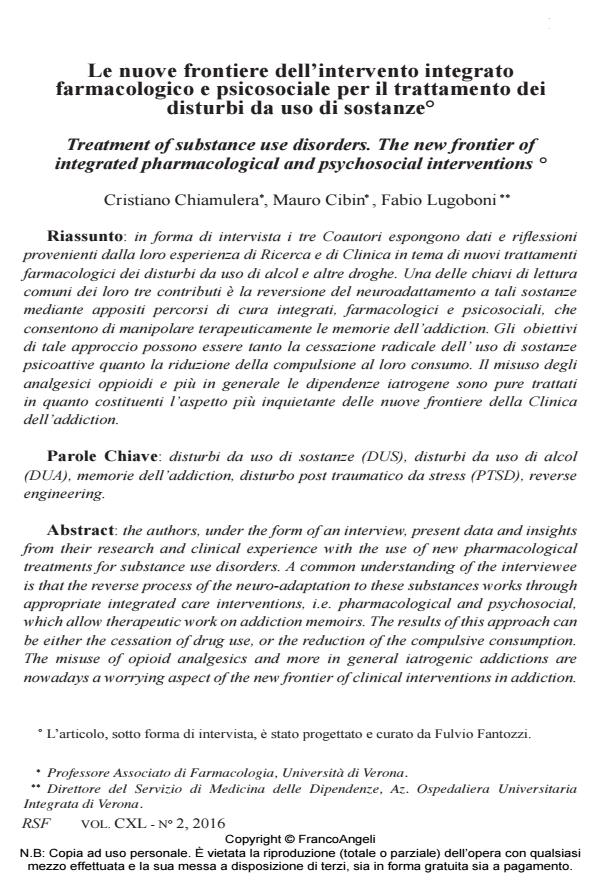Le nuove frontiere dell’intervento integrato farmacologico e psicosociale per il trattamento dei disturbi da uso di sostanze
Titolo Rivista RIVISTA SPERIMENTALE DI FRENIATRIA
Autori/Curatori Cristiano Chiamulera, Mauro Cibin, Fabio Lugoboni
Anno di pubblicazione 2016 Fascicolo 2016/2
Lingua Italiano Numero pagine 23 P. 103-125 Dimensione file 223 KB
DOI 10.3280/RSF2016-002007
Il DOI è il codice a barre della proprietà intellettuale: per saperne di più
clicca qui
Qui sotto puoi vedere in anteprima la prima pagina di questo articolo.
Se questo articolo ti interessa, lo puoi acquistare (e scaricare in formato pdf) seguendo le facili indicazioni per acquistare il download credit. Acquista Download Credits per scaricare questo Articolo in formato PDF

FrancoAngeli è membro della Publishers International Linking Association, Inc (PILA)associazione indipendente e non profit per facilitare (attraverso i servizi tecnologici implementati da CrossRef.org) l’accesso degli studiosi ai contenuti digitali nelle pubblicazioni professionali e scientifiche
In forma di intervista i tre Coautori espongono dati e riflessioni provenienti dalla loro esperienza di Ricerca e di Clinica in tema di nuovi trattamenti farmacologici dei disturbi da uso di alcol e altre droghe. Una delle chiavi di lettura comuni dei loro tre contributi è la reversione del neuroadattamento a tali sostanze mediante appositi percorsi di cura integrati, farmacologici e psicosociali, che consentono di manipolare terapeuticamente le memorie dell’addiction. Gli obiettivi di tale approccio possono essere tanto la cessazione radicale dell’ uso di sostanze psicoattive quanto la riduzione della compulsione al loro consumo. Il misuso degli analgesici oppioidi e più in generale le dipendenze iatrogene sono pure trattati in quanto costituenti l’aspetto più inquietante delle nuove frontiere della Clinica dell’addiction.
Parole chiave:Disturbi da uso di sostanze (DUS), disturbi da uso di alcol (DUA), memorie dell’addiction, disturbo post traumatico da stress (PTSD), reverse engineering.
Cristiano Chiamulera, Mauro Cibin, Fabio Lugoboni, Le nuove frontiere dell’intervento integrato farmacologico e psicosociale per il trattamento dei disturbi da uso di sostanze in "RIVISTA SPERIMENTALE DI FRENIATRIA" 2/2016, pp 103-125, DOI: 10.3280/RSF2016-002007